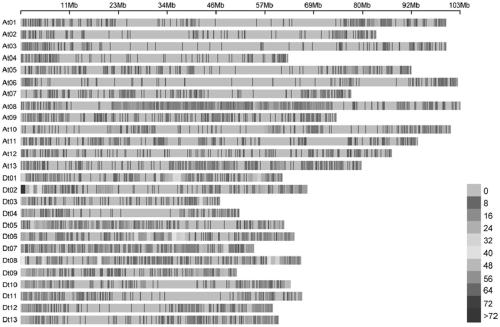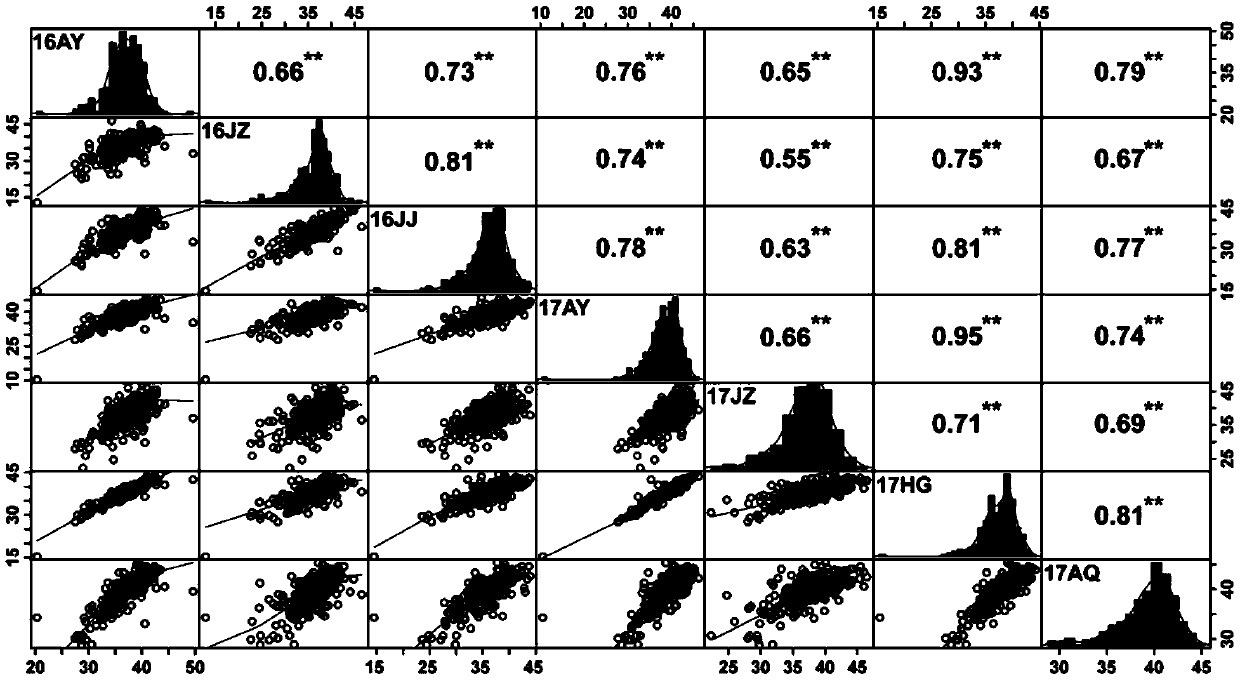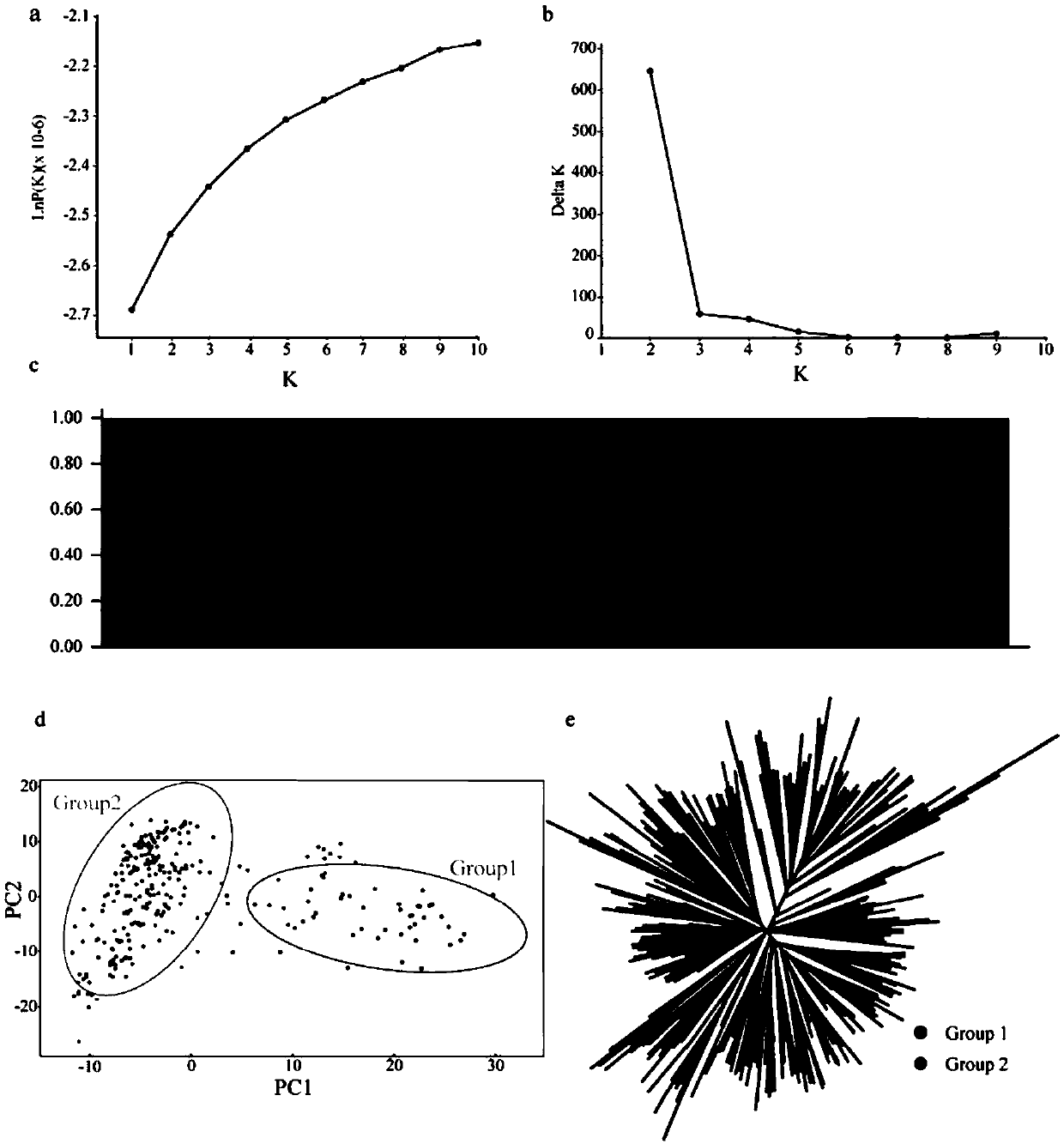Gene in significant correlation with characters of fiber yield, SNP marker and application of SNP marker
A gene and cotton technology, applied in the field of cotton lint traits molecular biology, can solve the problems of affecting lint traits, limited genetic basic research on lint traits, etc., and achieve the effect of convenient detection
- Summary
- Abstract
- Description
- Claims
- Application Information
AI Technical Summary
Problems solved by technology
Method used
Image
Examples
Embodiment 1
[0051] 1. Materials and methods
[0052] Selection of experimental materials and design of field experiments
[0053] In this study, we mainly collected representative cotton varieties that have played an important role in different historical stages from the national mid-term bank of cotton germplasm resources of the Cotton Research Institute of the Chinese Academy of Agricultural Sciences and the breedings accumulated in the long-term high-yield breeding practice of our research team. Basic materials, a total of 276 upland cotton materials, are used for subsequent correlation analysis.
[0054] These materials can be divided into five categories according to their geographical origin: Yellow River Valley varieties (YRR), Yangtze River Valley varieties (YtRR), Northwest Inland River Valley materials (NW), Northern early-maturing varieties (NSEMR) and varieties from other countries in the world. All materials were planted at five sites in 2016-2017. Namely: Anyang, Henan (20...
Embodiment 2
[0067] The DNA of the young leaf tissue of each material was extracted by the modified CTAB method. Materials were genotyped using the CottonSNP63K chip. GenomeStudio v2011.1 analysis software was used for quality control of SNP typing results. Then, the SNPs were further screened according to the criteria of call rate>85% and minimum allele frequency (MAF)>0.05. Finally, the SNP probe sequence was compared with the upland cotton reference genome TM-1 (Gossypium hirsutum (AD1) GenomeNAU-NBI Assembly v1.1&Annotation v1.1) to obtain the physical location of the SNP.
[0068] The alignment results showed that 14,977 SNPs were aligned to the scaffold region where the staining position was not determined, and 48,081 SNPs were aligned to the chromosome. These SNPs aligned to the chromosome will be used for further analysis. Then, according to the set filtering criteria, call rate>85% and MAF>0.05. Finally, 10660 high-quality SNPs were obtained and used in subsequent correlation a...
Embodiment 3
[0074] Based on the Bayesian model in STRUCTURE 2.3.4 software, the population structure analysis of 276 upland cotton materials was carried out. The number of groups (K) is set to 1-10, among which the Length of burn-in period (Length of burn-in period) is set to 10000, the Monte Carlo iteration (Marko chain monte carlo, MCMC) is set to 100000, and each K value is independent Run 5 times. Then, referring to the method of Evanno et al., the optimal number of subpopulations of the population was estimated according to the LnP(K) and ΔK values. The results of five runs of the optimal K value were integrated using CLUMPP software to obtain the population structure matrix (Q matrix). In addition, principal component analysis (PCA) and kinship analysis were performed using the GAPIT software package. Using PowerMarker v3.25 software to calculate polymorphic information content (Polymorphic information content, PIC), gene diversity (Gene diversity) and Nei's genetic distance. The...
PUM
 Login to View More
Login to View More Abstract
Description
Claims
Application Information
 Login to View More
Login to View More - R&D
- Intellectual Property
- Life Sciences
- Materials
- Tech Scout
- Unparalleled Data Quality
- Higher Quality Content
- 60% Fewer Hallucinations
Browse by: Latest US Patents, China's latest patents, Technical Efficacy Thesaurus, Application Domain, Technology Topic, Popular Technical Reports.
© 2025 PatSnap. All rights reserved.Legal|Privacy policy|Modern Slavery Act Transparency Statement|Sitemap|About US| Contact US: help@patsnap.com



